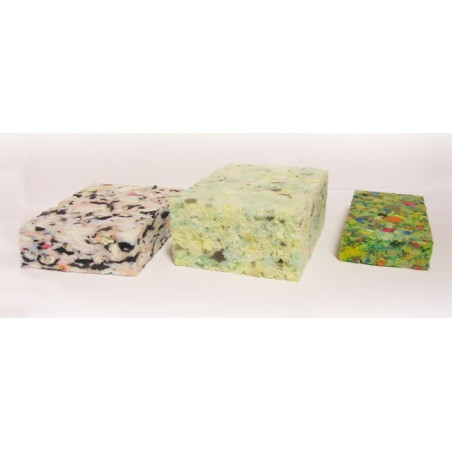



Acoustic Foam D80 (density 80kg / m3) for soundproofing dim. 1000mm x 1000mm, 40mm
Acoustic Foam soundproofing using false wall in combination with spring line
Acoustic foam 1m x 1m, Density 80 For acoustically insulating walls and ceiling, you can use a detached front wall or a detached ceiling. These walls and ceilings are made on the basis of spring rules in combination with acoustic foam. The acoustic foam is available in different thicknesses and different densities. The spring rails are available in thickness 40 mm. By using a retention wall, plate materials such as plasterboard etc. can be attached completely uncoupled, so that no sound energy can be transmitted to the rear wall. The use of acoustic foam in this wall prevents cavity resonance and the insulating properties of the wall will be better. An additional advantage of the acoustic foam is that it also offers good thermal insulation, ƛ = 0.035 W / mk, and will not be inferior to other cavity filling materials. Determine foam density: Foam with density 60-80 is available for walls and ceilings, density 120-160 is used for floors. D80 is the most commonly used density for a standard retaining wall, for floors it applies; the heavier the floor, the higher the density. Determine thickness: The foam must be filled the entire cavity so that there is no resonance in the cavity. In principle, the thickness of the spring rails can therefore be maintained, 40 mm or 80 mm. The thicker the retention wall, the better the sound-insulating effect will be. For even better sound insulation, the cavity can also be provided with an extra layer of Acousti block 3 mm. For mounting instructions for a detached wall / ceiling, click here Foam with density 60-80 is available for walls and ceilings, and densities 120-160 are used for floors. D80 is the most commonly used density for a standard retaining wall, for floors it applies; the heavier the floor, the higher the density. Determine thickness: The foam must be filled the entire cavity so that there is no resonance in the cavity. In principle, the thickness of the spring rails can therefore be maintained, 40 mm or 80 mm. The thicker the retention wall, the better the sound-insulating effect will be. For even better sound insulation, the cavity can also be provided with an extra layer of Acousti block 3 mm. For mounting instructions for a detached wall / ceiling, click here Foam with density 60-80 is available for walls and ceilings, and densities 120-160 are used for floors. D80 is the most commonly used density for a standard retaining wall, for floors it applies; the heavier the floor, the higher the density. Determine thickness: The foam must be filled the entire cavity so that there is no resonance in the cavity. In principle, the thickness of the spring rails can therefore be maintained, 40 mm or 80 mm. The thicker the retention wall, the better the sound-insulating effect will be. For even better sound insulation, the cavity can also be provided with an extra layer of Acousti block 3 mm. For mounting instructions for a detached wall / ceiling, click here the heavier the floor, the higher the density. Determine thickness: The foam must be filled the entire cavity so that there is no resonance in the cavity. In principle, the thickness of the spring rails can therefore be maintained, 40 mm or 80 mm. The thicker the retention wall, the better the sound-insulating effect will be. For even better sound insulation, the cavity can also be provided with an extra layer of Acousti block 3 mm. For mounting instructions for a detached wall / ceiling, click here the heavier the floor, the higher the density. Determine thickness: The foam must be filled the entire cavity so that there is no resonance in the cavity. In principle, the thickness of the spring rails can therefore be maintained, 40 mm or 80 mm. The thicker the retention wall, the better the sound-insulating effect will be. For even better sound insulation, the cavity can also be provided with an extra layer of Acousti block 3 mm. For mounting instructions for a detached wall / ceiling, click here For even better sound insulation, the cavity can also be provided with an extra layer of Acousti block 3 mm. For mounting instructions for a detached wall / ceiling, click here For even better sound insulation, the cavity can also be provided with an extra layer of Acousti block 3 mm. For mounting instructions for a detached wall / ceiling, click here
Do not take a higher density than D80, the sound insulation of walls is not better here. It is not true that the higher the density the better the soundproofing!